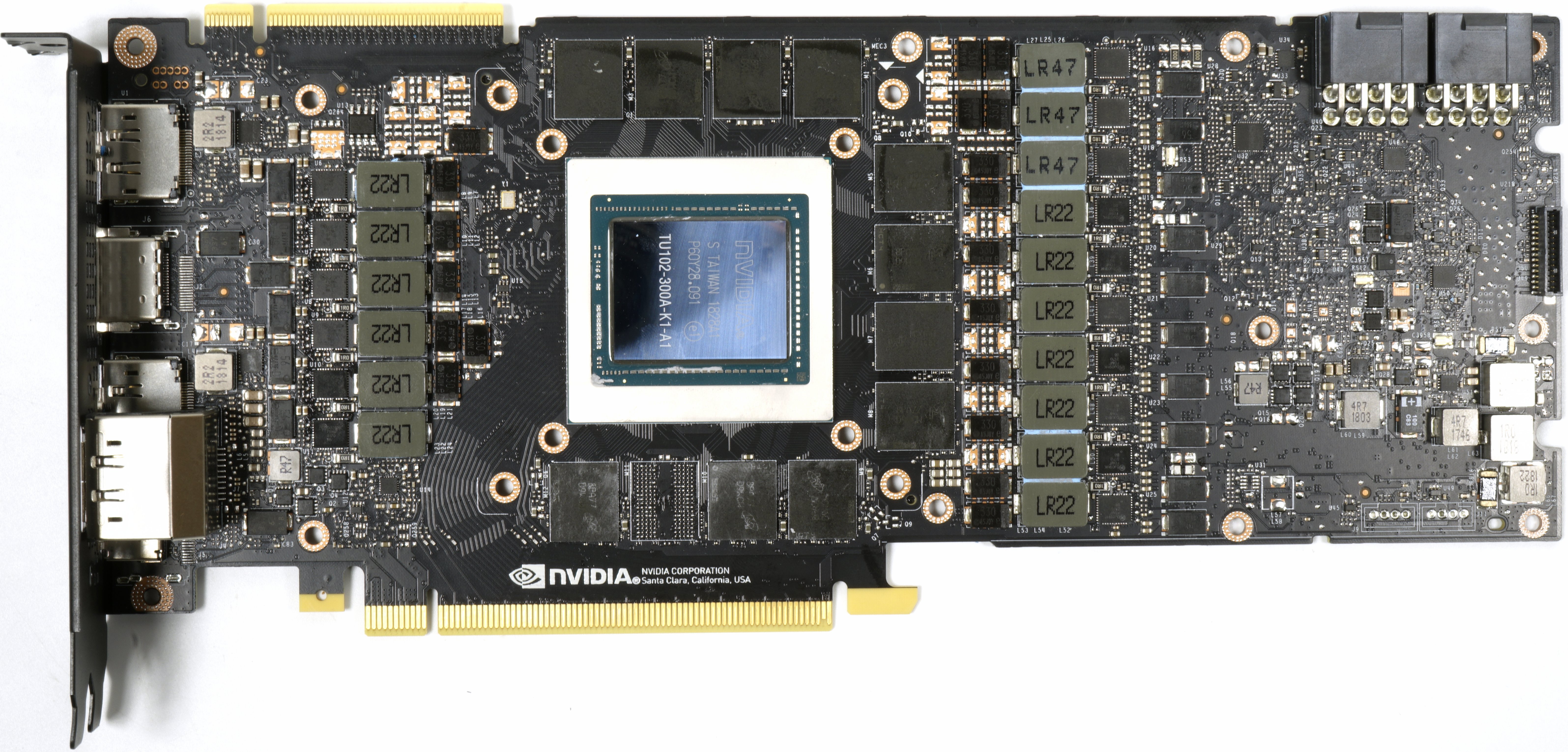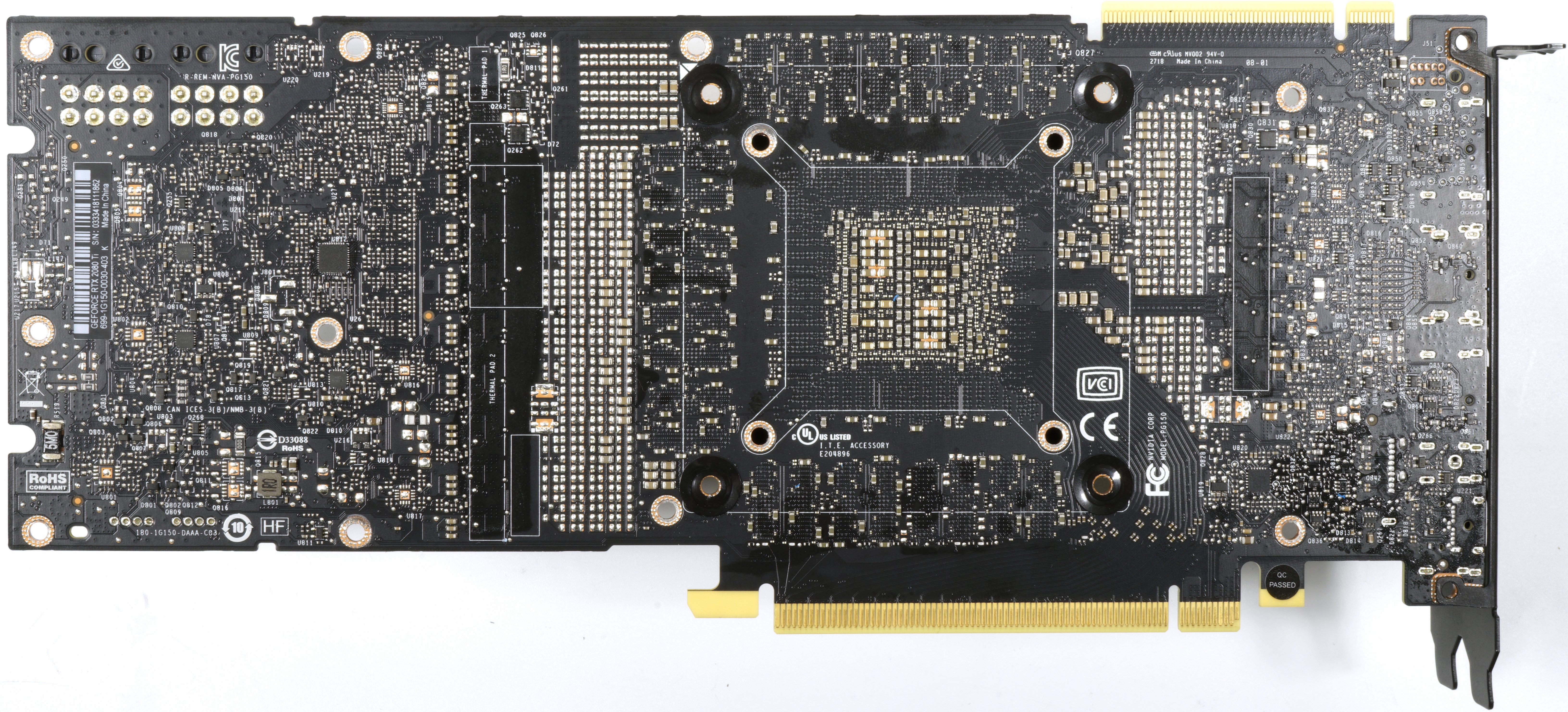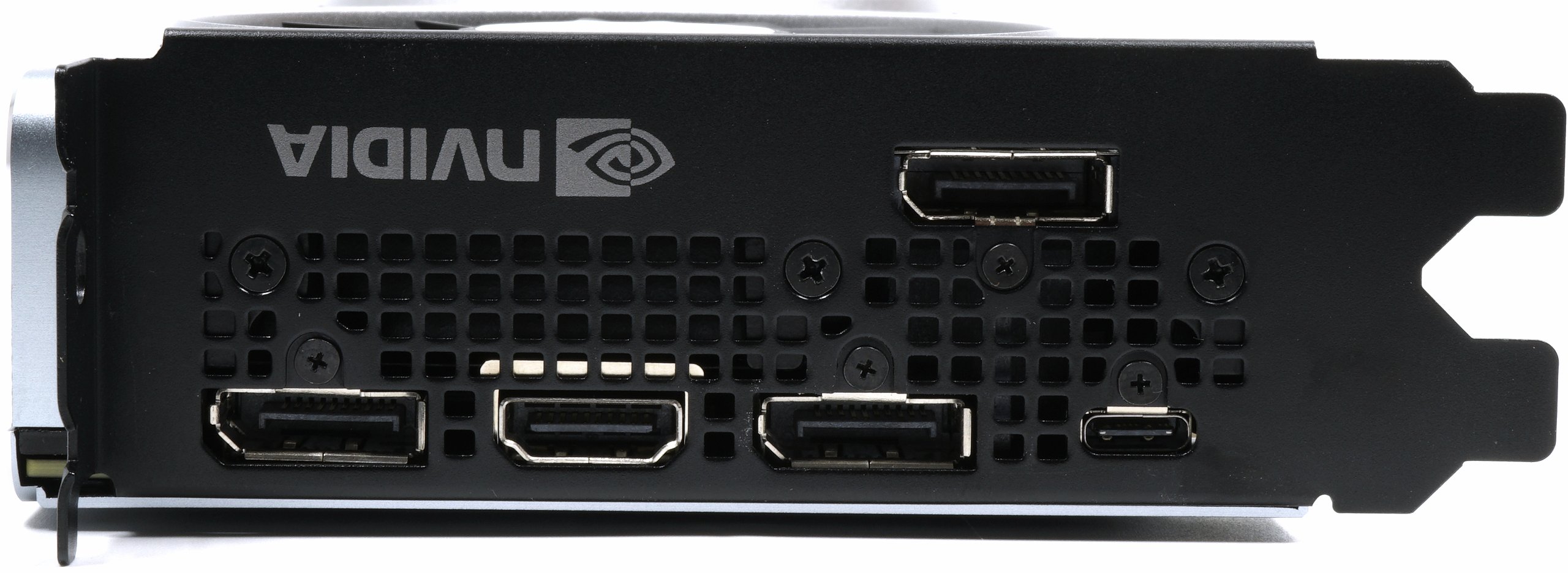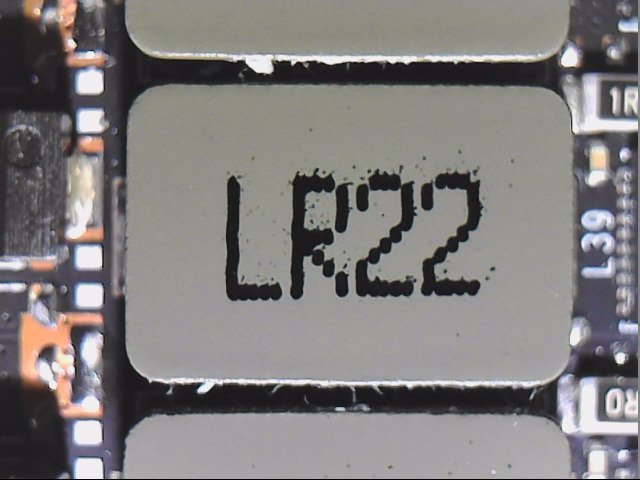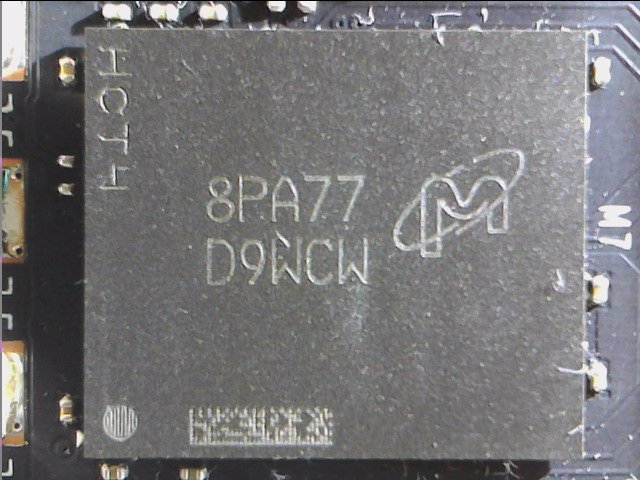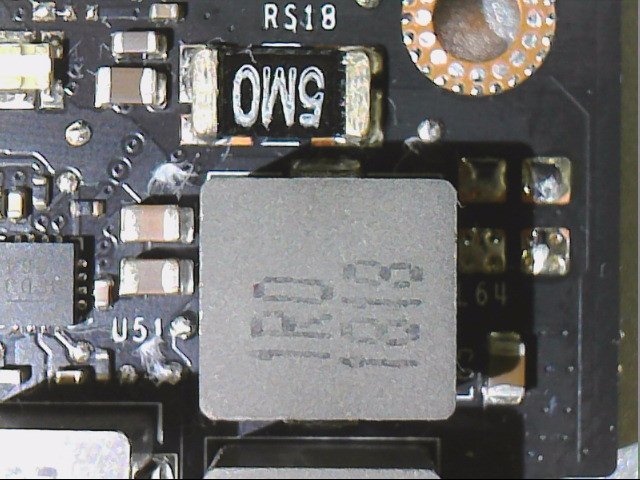Tom's Hardware Verdict
Nvidia’s GeForce RTX 2080 Ti is the first card we’ve tested able to deliver smooth frame rates at 4K with detail settings maxed out. Its halo features aren’t used in any games yet, but as those come online, the Turing architecture is expected to shine even brighter.
Pros
- +
Smooth performance at 4K with top quality settings
- +
Improved thermal solution performance helps sustain higher GPU Boost clocks
- +
Packed with future-looking tech to accelerate next-gen games with ray tracing and AI support
Cons
- -
$1200 price tag is out of reach for most gamers
- -
Dual axial fan design exhausts heat back into your case
Why you can trust Tom's Hardware
GeForce RTX 2080 Ti Founders Edition
GeForce RTX 2080 Ti is fast. Nobody will argue against that. What bothers gamers most is its price tag. The Founders Edition board costs $1200—71% higher than the flagship GeForce GTX 1080 Ti Nvidia launched back in 2017. Perhaps disappointingly, then, GeForce RTX 2080 Ti averages about 26% faster than its predecessor across our suite of 13 games at 4K.
But what if we told you it also beats Nvidia’s Titan V? In Battlefield 1, GeForce RTX 2080 Ti is 20% faster. In Forza Motorsport 7, the 2080 Ti enjoys a 22% advantage. Based on the two cards’ specifications, we weren’t expecting such a dramatic finish. Although the $3000 GV100-based Titan V is made for deep learning and not gaming, those results sure put GeForce RTX 2080 Ti’s $1200 price into context. Thus, if you can afford it, the RTX 2080 Ti, is one of the best graphics cards around.
Even more significant for the growing group of enthusiasts with 4K monitors, GeForce RTX 2080 Ti gives you playable performance at 3840x2160 without sacrificing detail settings. Yes, we turned off taxing anti-aliasing modes to test at 4K. However, our benchmarks reflect high-res, high-quality PC gaming above 60 FPS in every single title.
This is a moment we’ve anticipated for years. GeForce GTX 980 Ti was playable at 4K if you dialed down the details. Although GeForce GTX 1080 got us a little closer to gaming nirvana, it clearly wasn’t the stunner needed for smooth performance at max-quality 4K. Then, GeForce GTX 1080 Ti tempted us to finally declare a 4K champion. But we’re glad we held off. GeForce RTX 2080 Ti finally makes those Ultra settings viable at 3840x2160.
TU102: The Makings of a Gaming Beast
How does GeForce RTX 2080 Ti achieve this? Well, if you missed our comprehensive analysis of the card’s inner workings, check out Nvidia’s Turing Architecture Explored: Inside the GeForce RTX 2080. To summarize, though, today’s subject is based on TU102, a 754-square-millimeter GPU composed of 18.6 billion transistors fabricated on TSMC’s 12nm FinFET manufacturing process. It's loaded down with higher quantities of rendering resources that operate more efficiently than anything we've ever tested.
A complete TU102 processor comprises six Graphics Processing Clusters (GPCs) made up of a Raster Engine and six Texture Processing Clusters (TPCs). Each TPC is composed of one PolyMorph Engine (fixed-function geometry pipeline) and two Streaming Multiprocessors (SMs). At the SM level, we find 64 CUDA cores, eight Tensor cores, one RT core, four texture units, 16 load/store units, 256KB of register file space, four L0 instruction caches, and a 96KB configurable L1 cache/shared memory structure.
Multiply all of that out and you get a GPU with 72 SMs, 4608 CUDA cores, 576 Tensor cores, 72 RT cores, 288 texture units, and 36 PolyMorph engines. Those resources are fed by 12 32-bit GDDR6 memory controllers, each attached to an eight-ROP cluster and 512KB of L2 cache yielding an aggregate 384-bit memory bus, 96 ROPs, and a 6MB L2 cache. Each SM does contain a pair of FP64-capable CUDA cores as well, yielding a double-precision rate that’s 1/32 of TU102’s FP32 performance.
Get Tom's Hardware's best news and in-depth reviews, straight to your inbox.
| Header Cell - Column 0 | GeForce RTX 2080 Ti FE | GeForce RTX 2080 FE | GeForce GTX 1080 Ti FE | GeForce GTX 1080 FE |
|---|---|---|---|---|
| Architecture (GPU) | Turing (TU102) | Turing (TU104) | Pascal (GP102) | Pascal (GP104) |
| CUDA Cores | 4352 | 2944 | 3584 | 2560 |
| Peak FP32 Compute | 14.2 TFLOPS | 10.6 TFLOPS | 11.3 TFLOPS | 8.9 TFLOPS |
| Tensor Cores | 544 | 368 | N/A | N/A |
| RT Cores | 68 | 46 | N/A | N/A |
| Texture Units | 272 | 184 | 224 | 160 |
| Base Clock Rate | 1350 MHz | 1515 MHz | 1480 MHz | 1607 MHz |
| GPU Boost Rate | 1635 MHz | 1800 MHz | 1582 MHz | 1733 MHz |
| Memory Capacity | 11GB GDDR6 | 8GB GDDR6 | 11GB GDDR5X | 8GB GDDR5X |
| Memory Bus | 352-bit | 256-bit | 352-bit | 256-bit |
| Memory Bandwidth | 616 GB/s | 448 GB/s | 484 GB/s | 320 GB/s |
| ROPs | 88 | 64 | 88 | 64 |
| L2 Cache | 5.5MB | 4MB | 2.75MB | 2MB |
| TDP | 260W | 225W | 250W | 180W |
| Transistor Count | 18.6 billion | 13.6 billion | 12 billion | 7.2 billion |
| Die Size | 754 mm² | 545 mm² | 471 mm² | 314 mm² |
| SLI Support | Yes (x8 NVLink, x2) | Yes (x8 NVLink) | Yes (MIO) | Yes (MIO) |
Putting It All Together: GeForce RTX 2080 Ti
The TU102 found on GeForce RTX 2080 Ti isn’t a complete processor, though. Whether Nvidia wanted to leave room for a Titan-class model or found yields of fully-functional GPUs unsatisfactory above a certain bin, the RTX 2080 Ti has two of its TPCs disabled, leaving the card with 4352 CUDA cores, 544 Tensor cores, 68 RT cores, 544 texture units, and 34 PolyMorph engines.
One of TU102’s 32-bit memory controllers is also turned off, creating an aggregate 352-bit bus that moves data to 88 ROPs and 5.5MB of L2 cache. Nvidia matches its strategically-hobbled GPU to Micron’s MT61K256M32JE-14:A modules. Eleven of these populate the RTX 2080 Ti’s PCB, leaving one emplacement vacant. Nevertheless, theoretical peak bandwidth rises sharply compared to the previous generation cards due to GDDR6’s higher data rate. At 14 Gb/s on a 352-bit interface, you’re looking at 616 GB/s. In comparison, GDDR5X at 11 Gb/s held GeForce GTX 1080 Ti to 484 GB/s.
On the Founders Edition card, a base core frequency of 1350 MHz jumps all the way up to a typical GPU Boost rate of 1635 MHz, so long as GeForce RTX 2080 Ti is running cool enough. And because Nvidia cites peak compute performance using GPU Boost numbers, its top-end model achieves up to 14.2 TFLOPS of single-precision math.
That frequency is overclocked relative to Nvidia’s reference specification. As a result, the Founders Edition model has a slightly higher 260W TDP rating. A PCIe slot, an eight-pin power connector, and a six-pin power connector would theoretically be capable of servicing such a limit. However, Nvidia instead uses two supplementary eight-pin connectors, giving its GeForce RTX 2080 Ti Founders Edition potential headroom for overclocking.
Moving back from the PCIe connectors to GeForce RTX 2080 Ti's power supply, we count three phases for the GDDR6 memory and a corresponding PWM controller up front. A total of 13 phases remain, according to Nvidia. But that can't be right, can it? Even with six phase-doubled circuits, there would be one phase leftover to act as a load balancer. The numbers just don't add up.
In reality, it appears that five phases are fed by the eight-pin connectors and doubled. With two control loops per phase, 5*2=10 voltage regulation circuits. The remaining three phases to the left of the GPU are fed by the motherboard's PCIe slot and not doubled. That gives us Nvidia's lucky number 13 (along with a smart load distribution scheme). Of course, implementing all of this well requires the right components...
GPU Power Supply
Front and center in this design is uPI's uP9512 eight-phase buck controller specifically designed to support next-gen GPUs. Per uPI, "the uP9512 provides programmable output voltage and active voltage positioning functions to adjust the output voltage as a function of the load current, so it is optimally positioned for a load current transient."
The uP9512 supports Nvidia's Open Voltage Regulator Type 4i+ technology with PWMVID. This input is buffered and filtered to produce a very accurate reference voltage. The output voltage is then precisely controlled to the reference input. An integrated SMBus interface offers enough flexibility to optimize performance and efficiency, while also facilitating communication with the appropriate software.
All 13 voltage regulation circuits are equipped with an ON Semiconductor FDMF3170 Smart Power Stage module with integrated PowerTrench MOSFETs and driver ICs.
As usual, the coils rely on encapsulated ferrite cores, but this time they are rectangular to make room for the voltage regulator circuits.
Memory Power Supply
Micron's MT61K256M32JE-14:A memory ICs are powered by three phases coming from a second uP9512. The same FDMF3170 Smart Power Stage modules crop up yet again. The 470mH coils offer greater inductance than the ones found on the GPU power phases, but they're completely identical in terms of physical dimensions.
The input filtering takes place via three 1μH coils, whereby each of the three connection lines has a matching shunt. This is a very low resistance to which voltage drop is measured in parallel and passed on to the telemetry. Through these circuits, Nvidia is able to limit board power in a fairly precise way.
Unfortunately for the folks who like a bit of redundancy, this card only comes equipped with one BIOS.
How We Tested GeForce RTX 2080 Ti
Nvidia’s latest and greatest will no doubt be found in one of the many high-end platforms now available from AMD and Intel. Our graphics station still employs an MSI Z170 Gaming M7 motherboard with an Intel Core i7-7700K CPU at 4.2 GHz, though. The processor is complemented by G.Skill’s F4-3000C15Q-16GRR memory kit. Crucial’s MX200 SSD remains, joined by a 1.4TB Intel DC P3700 loaded down with games.
As far as competition goes, the GeForce RTX 2080 Ti is rivaled only by the $3000 Titan V. We add that card to our test pool this time around, along with GeForce GTX 1080 Ti, Titan X, GeForce GTX 1080, GeForce GTX 1070 Ti, and GeForce GTX 1070 from Nvidia. AMD is represented by the Radeon RX Vega 64 and 56. All cards are either Founders Edition or reference models. We do have some partner boards in-house from both Nvidia and AMD, and plan to use those for third-party reviews.
Our benchmark selection now includes Ashes of the Singularity: Escalation, Battlefield 1, Civilization VI, Destiny 2,Doom, Far Cry 5,Forza Motorsport 7, Grand Theft Auto V, Metro: Last Light Redux, Rise of the Tomb Raider, Tom Clancy’s The Division, Tom Clancy’s Ghost Recon Wildlands, The Witcher 3 and World of Warcraft: Battle for Azeroth. We’re working on adding Monster Hunter: World, Shadow of the Tomb Raider, Wolfenstein II, and a couple of others, but had to scrap those plans due to very limited time with Nvidia’s final driver for its Turing-based cards.
The testing methodology we're using comes from PresentMon: Performance In DirectX, OpenGL, And Vulkan. In short, all of these games are evaluated using a combination of OCAT and our own in-house GUI for PresentMon, with logging via AIDA64.
All of the numbers you see in today’s piece are fresh, using updated drivers. For Nvidia, we’re using build 411.51 for GeForce RTX 2080 Ti and 2080. The other cards were tested with build 398.82. Titan V’s results were spot-checked with 411.51 to ensure performance didn’t change. AMD’s cards utilize Crimson Adrenalin Edition 18.8.1, which was the latest at test time.
MORE: Best Graphics Cards
MORE: Desktop GPU Performance Hierarchy Table
MORE: All Graphics Content
Current page: GeForce RTX 2080 Ti Founders Edition
Next Page Deep Learning Super-Sampling: Our First Taste of Quality and Performance-
A Stoner Conclusion, let them hold onto these card until they can lower the price to about $700Reply -
pontiac1979 "Waste of time to write a review. "Just buy it"."Reply
Oh yeah, god forbid Tom's does an in-depth review of the latest and greatest. Keyword greatest. If you desire 4K gaming and have the funds available, why wouldn't you? -
ubercake I'm probably going to buy one... Though it's not my fault... I feel like the Russians are compelling me to do this by way of Facebook. I'm a victim in this whole Nvidia marketing scam. Don't judge.Reply
That being said, I like high-quality, high-speed graphics performance. This may also be influencing my decision.
Great review! -
AnimeMania How much of the performance increase is due to using GDDR6 memory? I know this makes the cards perform better the higher the resolution is, how does it effect other aspects of the video cards.Reply -
teknobug "Just buy it" they said...Reply
If you're in Canada, you might not want to pay the price of these. -
chaosmassive While I appreciate this very detailed and nicely written review, its kinda redundantReply
because I think Avram has already reviewed this card with his opinion on late august
with the conclusion was "just buy it" -
wiyosaya SMH I don't understand the reasoning for comparing a $3k known non-gaming card with a $1.2k gaming card. Are there really gamers our there ignorant enough, other than those with deep pockets who want bragging rights, to purchase the $3K card for gaming when they know it is not meant for gaming? Or is this to differentiate Tom's from the other tech sites in order to inspire confidence in Tom's readers?Reply
Personally, I would have rather seen the 2080 Ti compared against 1080 Ti even if it Tom's comes to the same conclusions as the other tech web sites.
The comparison in this article does not make me want to rush out and buy it because it is $1.8k cheaper than a non-gaming card. I really hate to say it, but with the premise of this review being somewhat along the lines of "lookie hereee kiddies. Heree's a gaming card for $1.2k that beets a $3k non-gaming card" turned this review into a TL;DR review for me.




